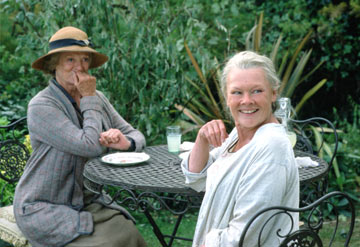Ladies in Lavender: Stargazy Pie Recipe 🥁🥁🥁🥁1/2
/Year Released: 2005
Directed by: Charles Dance
Starring: Judi Dench, Maggie Smith, Daniel Bruhl, Natascha McElhone, Miriam Margolyes
(PG-13, 103 min.)

"Age does not protect you from love, but love, to some extent, protects you from age" Jeanne Moreau
Ladies in Lavender is the little unappreciated gem Different Drummer has been promising you. If you think story telling is all about plot, you will be disappointed, like most of the assorted critics that damned it with faint praise. But if you want to see the human heart revealed in its infinite complexity, run don’t walk to watch this classic.
Even I was put off by the sighing critics who said Dame Judi Dench and Maggie Smith’s tremendous acting was wasted on such a lightweight vehicle. I must thank the two women coming out of the theatre for my renewed interest. When two strangers are so moved that they feel compelled to share their awe, you have something. I was determined to see what they called the best movie they’d seen in years.
I’m going to be a bit snippy and say this is the real Emperor’s Clothes. If you don’t see its quality, that is your shortcoming. Sure, a film about the romantic longings of two English spinsters, where the closest you get to nudity is a very modest 1936 style bathing suit and physical contact is limited to a hesitant touch, will not be everyone’s cup of tea.
The film only teases us with imagined intrigues. The strapping young foreigner who washes ashore after a particularly bad storm off the Cornish coast is a mystery and perhaps a sinister one at that. Andrea appears to be Polish, speaks German, and talks vaguely about being on his way to America, although no known ships have wrecked off this English coast. The wireless crackles with tales of Hitler’s buildup like the taut violin strings that Andrea shows he can play with more than ordinary talent. When an exquisite vacationer from Russia just happens to overhear Andrea’s virtuoso notes singing through shuttered windows, she feels compelled to approach Ursula and Janet Widdington’s seaside abode. Is this some prearranged setup for espionage, we wonder?
But it is not suspicion but something infinitely more tender that is awakened, in varying degrees, in the hearts and minds of Ursula (Dench) and Janet Widdington (Smith). Villagers carry a soggy Andrea up the craggy coast and then to the empty second floor bedroom adjacent to the one that the sisters share. Having a man so near is a distinct wrinkle in their sheltered lives, which consist mostly of tending roses, knitting, and sipping tea out of fragile cups brought to them by anything but fragile housekeeper Dorcas.
Earthy and rotund Dorcas takes care of the more delicate necessities such as emptying Andrea’s bedpan and helping him into the striped pajamas that once belonged to Ursula and Janet’s father.
The sisters treat him like some exotic broken-winged bird, and they do their best to build it a gilded cage. Janet retrieves a weathered German text to communicate with him, while Ursula takes it upon herself to teach him English, littering the prim room with lettered signs pinned to everything. “You’re not teaching him English, you’re just putting holes in the furniture,” Janet scolds.
The girls, for that is what they are under the sagging skin and spectacles, pool their resources to buy Andrea a suit, fussing over it with the same practical fluster one does over a prom dress. Janet, a young widow since the Great War, feels a sort of motherly possessiveness with school girl overtones, but satisfies herself with cooking her specialty, stargazey pie, and trimming Andrea’s unruly locks. Never married (or bedded we safely assume) Ursula picks up the ginger curls and steals them away behind her skirts. Her looks of adolescent longing earn Janet’s raised eyebrows, but when Ursula wanders into Andrea’s bedroom one night, sterner measures are called for.
The interplay between the two sisters, prim and angular Janet, who speaks volumes as she peers down through her spectacles or furrows her brow, and Ursula, whose blush transforms her round face with an adolescent glow, is what makes the film. The Cornish coast will lure you to a travel agent so you can rub shoulders at the local pub with cast members you will swear are not actors but gentle time travelers happily settled in James Herriot’s England for eternity. Is it too late to make a reservation?
—Kathy Borich

Film-Loving Foodie
The excellent pastry cook Dorcas is relegated to search high and wide for the proper ingredients, but it is Janet herself who takes great pains to make a somewhat peculiar dish for Andrea. With great care she turns her slender hands to the task of making Stargazy pie, “so named because the fishes’ heads were left outside the pastry gazing upwards.”
Strange as it may seem, it is certainly a signature dish of Cornwall, ”made for special occasions and to amuse children.” Perhaps those childhood memories spur on the lanky spinster, though there are hints that one mustn’t ever trust a skinny chef. The rotund Dorcas would probably have made a dish that inspired Ursula to clean her plate instead of toying with what she explains is “ever so filling.”
Stargazy Pie
“The Cornish invented the most ghoulish fish dish in history - Stargazey pie. Pilchards or herrings were sandwiched whole, and often unboned, in a single or double-crust pie with their little heads poking through the pastry. How your mouth was supposed to separate fish bones from flesh and pastry is not recorded (nor why this gruesome dish underwent a brief revival in the 1970s.)
This Cornish Pie is probably so called because the fishes' heads are left outside the pastry, gazing upwards. Originally they were arranged like this because the oil drained back into the pie, so nothing was wasted and the pie was moistened.
In some parts of Cornwall a mashed potato crust is used instead of pastry. Pilchards were once so plentiful in Cornwall that they were hung on lines to dry. Stargazey pie was a fun dish, made for special occasions, or to amuse children.” Helen Gaffney
Ingredients
Serves: 4-6
6 Tablespoon Fresh white breadcrumbs
150 ml Milk (5 fl oz)
2 Tablespoon Fresh parsley, chopped
3 Tablespoon Lemon juice, plus the zest
1 Medium Onion, chopped
6 Pilchards, filtered with heads left on
2 Hard-boiled eggs, chopped
1 Rashers Bacon, rinded and chopped
Salt and freshly ground black pepper
150 ml Dry cider (5 fl oz)
225 Gram Puff pastry, or shortcrust or flaky pastry (8 oz)
Method
Soak the breadcrumbs in the milk and leave to swell a little. Add the parsley, lemon juice, lemon zest and onion and mix well.
Divide this stuffing between the fish, spreading it over the flat fillets. Fold them over, then put them into a round ovenproof dish, tails downwards and with the heads on the edge.
Put the chopped eggs, bacon, seasoning and cider all around and in between the fish.
Roll out the pastry to fit the dish. Press on, leaving the fish heads exposed on the rim.
Bake at 220 °C/ 425 °F/ Gas 7 for 15 minutes. Reduce the oven to 190 °C / 375 °F / Gas 5 and cook for a further 25 minutes.
You can use herrings or mackerel in place of the pilchards.
Recipe Source: The Great British Kitchen

















